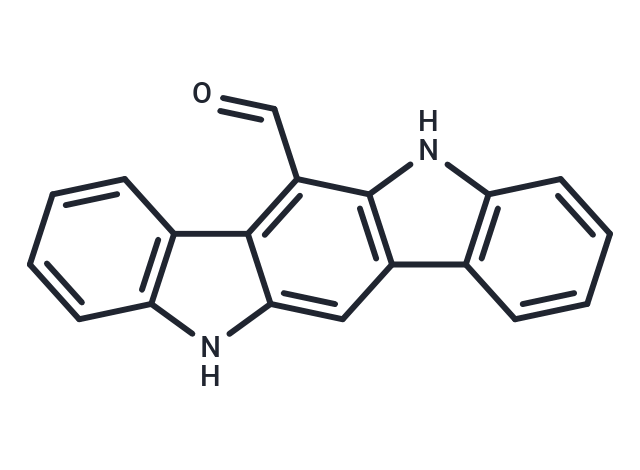Shopping Cart
Remove All Your shopping cart is currently empty
Your shopping cart is currently empty
FICZ (6-Formylindolo[3,2-b]carbazole) is a potent aryl agonist for the hydrocarbon receptor (AhR, Kd: 70 pM).

| Pack Size | Price | USA Warehouse | Global Warehouse | Quantity |
|---|---|---|---|---|
| 1 mg | $45 | In Stock | In Stock | |
| 5 mg | $93 | In Stock | In Stock | |
| 10 mg | $140 | In Stock | In Stock | |
| 25 mg | $275 | In Stock | In Stock | |
| 50 mg | $466 | In Stock | In Stock | |
| 100 mg | $658 | - | In Stock | |
| 200 mg | $938 | - | In Stock | |
| 1 mL x 10 mM (in DMSO) | $143 | In Stock | In Stock |
| Description | FICZ (6-Formylindolo[3,2-b]carbazole) is a potent aryl agonist for the hydrocarbon receptor (AhR, Kd: 70 pM). |
| Targets&IC50 | AhR:70 pM (Kd) |
| In vitro | FICZ (0.01 nM-1 μM) alone or in combination with 50 nM MNF induces sustained CYP1A1 activity and leads to oxidative stress and activation of apoptosis via a mitochondrial-dependent pathway. In HepG2 cells, FICZ stimulates cell growth at low concentrations but inhibits cell growth at high concentrations [1]. FICZ (10-30 μM) significantly decreases CEH viability with an estimated LC50 (95% confidence intervals) of 14 μM. FICZ shows concentration-dependent effects on EROD activity in CEH cultures, with the mean EC50 values at 3, 8, and 24 h of 0.016 nM, 0.80 nM, and 11 nM, respectively [2]. CYP1 inhibition in the presence of FICZ results in enhanced AHR activation, suggesting that FICZ accumulates in the cell when its metabolism is blocked. CYP1 enzymes play a role in regulating the biological effects of FICZ [3]. FICZ treatment increases transcript expression of CYP1A1 in a dose-dependent manner in both the parental iPSC line and the CYP1A1 targeted clone [4]. |
| Cell Research | The cell viability of CEH treated with FICZ or TCDD is studied with the untreated cells (used as a live cell control) and sodium hypochlorite (5%)-treated cells (used as a dead cell control). This assay is based upon the bioluminescent measurement of adenosine triphosphate (ATP) that is present in all metabolically active cells. Luciferase is utilized in this method to catalyze the formation of light from ATP and luciferin. CEH is lysed 24 h after dosing and the luminescence emitted from the ATP-dependent oxidation of luciferin is measured with a LuminoSkan Ascent luminometer [2]. |
| Synonyms | 6-Formylindolo[3,2-b]carbazole |
| Molecular Weight | 284.31 |
| Formula | C19H12N2O |
| Cas No. | 172922-91-7 |
| Smiles | O=Cc1c2[nH]c3ccccc3c2cc2[nH]c3ccccc3c12 |
| Relative Density. | 1.463 g/cm3 (Predicted) |
| Color | Yellow |
| Appearance | Solid |
| Storage | keep away from direct sunlight | Powder: -20°C for 3 years | In solvent: -80°C for 1 year | Shipping with blue ice/Shipping at ambient temperature. | |||||||||||||||||||||||||||||||||||
| Solubility Information | DMSO: 30 mg/mL (105.52 mM), Sonication is recommended. | |||||||||||||||||||||||||||||||||||
| In Vivo Formulation | 10% DMSO+90% Corn Oil: 1 mg/mL (3.52 mM), Sonication is recommeded. Please add the solvents sequentially, clarifying the solution as much as possible before adding the next one. Dissolve by heating and/or sonication if necessary. Working solution is recommended to be prepared and used immediately. The formulation provided above is for reference purposes only. In vivo formulations may vary and should be modified based on specific experimental conditions. | |||||||||||||||||||||||||||||||||||
Solution Preparation Table | ||||||||||||||||||||||||||||||||||||
DMSO
| ||||||||||||||||||||||||||||||||||||
| Size | Quantity | Unit Price | Amount | Operation |
|---|

Copyright © 2015-2025 TargetMol Chemicals Inc. All Rights Reserved.